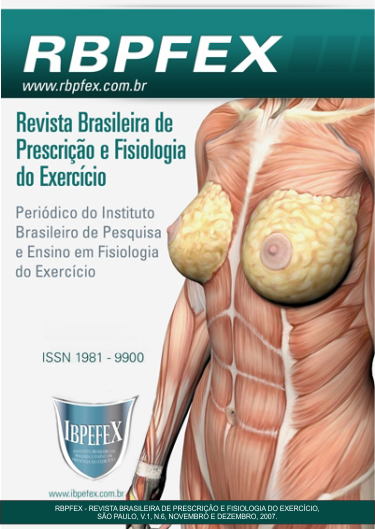The interference of the use of the mask for captation of gases in the performance and subjectivity of effort of test ergoespirometric
Abstract
Objective: to compare the stress testing and the cardiopulmonary exercise testing in relation to the total of exercises and perception of physique tiredness based in the Borg’s referred effort literature. Stuff and methods: They were submitted to two tests, with a break of three to five days, fourteen men, of average age of 27.6 years old, average weight of 80.5 Kg , height of 177.8 cm with moderate conditional fitness, practically of straight training and aerobic training, using the same protocol in step. The test t of Student was used to measure the meanness statistic of the difference of time between the tests. Argument: After the collecting data and the comparative analysis between these two methods, deduce that the cardiopulmonary exercise testing advance the time in the exhaustion perception, reducing the exercise time caused by the use of the mask. Conclusion: Although this inconvenience and considering that the stress testing, in some group, super estimate the VO2 peak, the cardiopulmonary exercise testing is the most recommended with the goal of exercise prescription.
References
- Chalela, W.A.; Moffa, P.J.; Meneghetti, J.C. Editado por Ramires, J.A.; Oliveira, S.A. Estresse Cardiovascular: Princípios e Aplicações Clínicas. São Paulo, Editora Roca, 2004.
- Costa, R.V.C.; Carreira, M.A.M.Q. Ergometria. São Paulo: Editora Atheneu, 2007.
- Forjaz, C.L.M. A duração do exercício determina a magnitude e a duração da hipotensão pós-exercício. Arquivo Brasileiro de Cardiologia, São Paulo, v. 70, n. 2,1998.
- Ghorayeb, Nabil.; Dioguardi, Giuseppe S. Tratado de Cardiologia do Exercício e do Esporte. São Paulo, Editora Atheneu, 2007.
- Negrão, C.E.; Barreto, A.C.P. Cardiologia do Exercício: Do atleta ao cardiopata. Barueri, SP: Editora Manole, 2006.
- Nogueira, F.S.; Pompeu, F.A.M.S. Modelos para predição da carga máxima no teste clínico de esforço cardiopulmonar. Arquivo Brasileiro de Cardiologia, São Paulo, v. 87, n. 2, 2006.
- Guimarães, J.I.; Stein, R.; Vilas-Boas, F.; Galvão, F.; Lucas da Nóbrega, A.C.; Castro, R.R.T. de.; Herdy, A.H.; Chalella, W.A.; Araújo, C.G.S. de.; Brito, F.S. de. Normatização de técnicas e equipamentos para realização de exames em ergometria e ergoespirometria. Arquivo Brasileiro de Cardiologia, São Paulo, v. 80, n. 4, 2003.
- Powers, S.K.; Howley, E.T. Fisiologia do exercício: Teoria e aplicação ao condicionamento e ao desempenho. Barueri – SP, 3º edição, p. 273. 2000.
- Rodrigues, A.N.; Perez, A.J.; Cartetti, N.S.; Bissoli, C.R.A. Valores de consumo máximo de oxigênio determinados pelo teste cardiopulmonar em adolescentes: uma proposta de classificação. Jornal de Pediatria (Rio de Janeiro)., Porto Alegre, v. 82, n. 6, 2006.
- Rondon, M.U.P.B.; Forjaz, C.L.M.; Nunes, N.; Amaral, S.L.; Barretto, A.C.P.; Negrão, C.E. Comparação entre a prescrição de intensidade de treinamento físico baseada na avaliação ergométrica convencional e na ergoespirométrica. Arquivo Brasileiro de Cardiologia, São Paulo, v. 70, n. 3, 1998.
- Silva, H.C.A.; Leite, J.J.; Carvalho, M.S.; Salum, P.N.B.; Vargas, F.S.; Levy, J.A. Teste de esforço cardioplumonar na avaliação de doenças musculares. Arquivo de Neuro-Psiquiatria, São Paulo, v. 56, n. 2, 1998.
- Sitta, J.A. Mensuração das alterações hemodinâmicas e respiratórias em indivíduos treinados através do teste de caminhada de seis minutos. São Paulo - Adamantina: Faculdades Adamantinenses Integradas/ FAI, 2004.
- Yazbek, J.R.P.; Carvalho, R.T. de.; Sabbag, L.M. dos S.; Battistella, L.R. Ergoespirometria. Teste de esforço cardiopulmonar, metodologia e interpretação. Arquivo Brasileiro de Cardiologia, São Paulo, v. 71, n. 5, 1998.
Authors who publish in this journal agree to the following terms:
- Authors retain the copyright and grant the journal the right of first publication, with work simultaneously licensed under the Creative Commons Attribution License BY-NC which allows the sharing of the work with acknowledgment of the authorship of the work and initial publication in this journal.
- Authors are authorized to enter into additional contracts separately for non-exclusive distribution of the version of the work published in this journal (eg, publishing in institutional repository or book chapter), with acknowledgment of authorship and initial publication in this journal.
- Authors are allowed and encouraged to post and distribute their work online (eg, in institutional repositories or on their personal page) at any point before or during the editorial process, as this can bring about productive change as well as increase impact and impact. citation of published work (See The Effect of Free Access).






